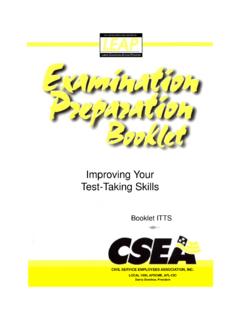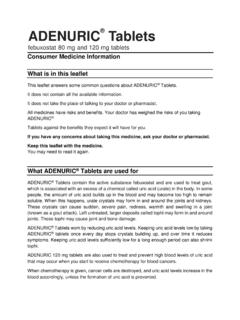Transcription of Information for patients Taking control of your non ...
1 Information for patients Taking control of your non-epileptic seizures Neurology Diagnosed with non-epileptic seizures? Some tips which may help How can you help yourself if you suffer from non-epileptic seizures? People often feel quite confused and helpless when they are diagnosed with non-epileptic seizures. They are told that they can't be treated with medication and may assume that there is nothing they can do. However, there are many things you can do that may help you to take control of your seizures and your life. Perhaps your friends and family can help as well. This booklet describes some approaches that many people find helpful. It may well take time to learn some of the techniques and to feel the benefits from them, so be patient and keep on trying.
2 Things you can do 1. Sensory grounding Do you get a warning before your attacks start? If so something called 'sensory grounding' may well allow you to fight off your seizures, or to delay the seizure until you are somewhere safe or more private. There are a number of ways of doing 'sensory grounding' but the one described below has been found to be helpful by many people. It is helpful to practice this when you are feeling OK so that you will remember it better when you need it. Also explain it to the people close to you. Then they can encourage you to use it if you forget in the heat of the moment. Many people find it helpful to carry something rough or textured around with them ( a rough pebble, small nail file) in their pocket or bag to rub in the sensory grounding.
3 Many people who have non-epileptic seizures also have anxiety and panic attacks. Sensory grounding can be a good way to take control of these too. This is what you do: 1. Feel something rough or textured, with your fingers and thumbs. Really focus on what this feels like as you rub it harder or softer, or in different directions. As you do this also put your feet flat on the floor and notice how solid the ground feels under your feet. If you are sitting down notice how solid the chair is underneath you. 2. Look around you and really focus on the things you can see. Describe them to yourself in detail. 3. Listen and see what sounds you can hear, people talking, birds singing, traffic noise etc 4.
4 Remind yourself where you are, what day of the week it is, what year it is, who you are with etc. 5. Remind yourself that you are safe. 2. Relaxation Many people find that their non-epileptic seizures are more likely to happen when they are tense. If you are tense you may find yourself squeezing your hands together or fiddling with things. You may tap your hands or feet, grind your teeth or hunch your shoulders. You may often feel 'wound up' or be easily startled. In this case some kind of regular relaxation may be helpful. There are many relaxation CD's available, which describe how to tense and relax your different muscle groups. Some CDs use soothing music, whale song etc. to help people relax.
5 Choose whatever works for you, or maybe just stop everything, listen to your favourite 'flop-out' music and give yourself time to unwind. You may find it helpful to put your relaxation CD onto an iPod or MP3 player if you have one so that you can use it wherever you like. 3. Abdominal breathing Many people with non-epileptic seizures or anxiety attacks find that their breathing becomes difficult or quick and shallow before a seizure. This is called hyperventilation. It can make you feel strange and light-headed and more likely to have a seizure. Abdominal breathing is a way of controlling your breathing. It can help you to fight off a seizure and feel more calm. Practice this at home and then use it whenever you start to think that you are going into a seizure, or if you start to feel anxious or panicky.
6 This is what you do: 1. Sit comfortably with one hand on your abdomen below the navel. 2. Slowly breathe in through your nose, and as you breathe in feel your stomach expand beneath your hand. 3. Pause for a count of 3. 4. Slowly breathe out through you nose and as you do so think "Relax". 5. Rest for a moment. 6. Repeat for 20 breaths or until you feel back in control . 4. Time out on the spot This is another good technique to use when you feel stressed or anxious. You can use it anywhere or anytime, and no-one else needs to know you are doing it. Just take a few minutes out of the stressful situation to go to the relaxing place in your mind. This is what you do: Think about a place you have been where you felt happy and relaxed.
7 It might be somewhere you have been on holiday or a special place in your home. It should be somewhere where you have felt calm and at peace. Imagine yourself in that place. Picture it clearly and think about what you can see there, what you can hear, how it smells, how it feels to be there. Get the image fixed in your mind so that you can call it up whenever you like. Now, when you are feeling stressed, imagine yourself opening a door which takes you to this place. In your mind picture yourself stepping into this place and soak up the atmosphere, feel the relaxation wash over you. You just need to do this for a few moments, and then return to where you were or what you were doing before.
8 5. Understand your triggers See if you can start to understand your seizures and what causes them. A good way to do this is to keep a seizure/emotions diary. Write down each time you have a seizure, when it happened and also what had been going on in your life that day. Particularly make note of things that might have made you feel emotional in any way. Also notice whether you were feeling tired, ill, where you were at the time, what you were doing. If you were watching TV, what were you watching? If you were chatting with friends what were you talking about? That way you may start to understand triggers that you were not aware of. For some people the seizure comes straight after the trigger, for others it could even be the following day.
9 6. Don't be over-cautious - look for solutions not for problems Attacks can be frightening, and some people react to this by stopping many of their normal activities. So people may stop work and stay in the house most of the time. They may never go anywhere alone, stop using buses and trains and avoid being with people because they are worried about having an attack. If you do this you are likely to get bored, feel frustrated, lonely, depressed, and to focus all your attention on your illness. This can make your stress levels go up, affect your self-confidence and put a strain on relationships. The longer you go without going out or doing much, the harder it becomes to start again, and the more depressing life becomes.
10 It is better to try to carry on with your normal activities as much as possible. Gradually start to do things and become more independent again, finding ways of tackling problems. Don't put life on hold until after the attacks stop. The happier and more interesting your life is, the better you will feel. This may well reduce the number of seizures you have. So plan outings, arrange treats for yourself, do things that are fun and interesting and plan things to look forward to. This way life becomes meaningful again. 7. Don't let yourself become isolated Many people with non-epileptic seizures feel embarrassed or ashamed of their attacks. They often don't know how to explain to people what is happening to them.






